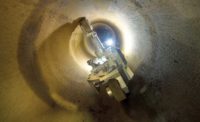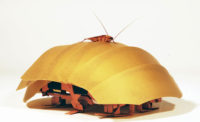A construction tech company that printed the walls of a 350-sq-ft “tiny house” in 48 hours in Austin, Texas, in March is now partnered with a nonprofit that aims to start printing walls for 800-sq-ft homes in El Salvador—in 24 hours for each—by the end of the year.
Based on current materials costs and with volume production, the finished cost of each home is expected to be $4,000.
The company’s main innovations are a robotic, gantry-style 3D printer that is large, mobile and intelligent enough to print a home, as well as a concrete recipe with the right handling and curing characteristics that’s simple enough to be locally sourced almost anywhere in the world.
“We’ve been at it for more than two years,” says Alex Le Roux, co-founder and engineer of ICON, about the development of the 3D printer his company calls the Vulcan. Made from aluminum, it can be moved by two people and runs on Gcode—a numerical control language commonly used to command machines in computer-aided manufacturing.
The Vulcan receives x-y-z coordinates with a value for the amount of material that needs to be placed in a 3D location, says Le Roux.
Site prep involves constructing a conventional slab-on-grade. Tracks are then placed on opposite edges of the slab for the printer to run on. Material is fed into a hopper, which has a level-detecting switch to measure the concrete supply, and the printer goes to work by maneuvering the gantry and nozzle to follow the coded placement instructions. Steel reinforcing is placed during the process by hand. Conventional methods are used for installing the roof, windows, doors, and electrical and plumbing elements.
“All the motors that run the machine are electric servos,” says Le Roux, which means the machine is light on DC power consumption. It can run on an 8-kW portable generator, Le Roux adds. The printer has printed about 5 linear inches of wall course per second in a horizontal direction.
ICON was spawned by Saturn Five, an Austin-based venture capital fund. It describes the startup as “disrupting the home building market with advanced robotics.”
Le Roux says other companies have printed buildings, but success depends on getting several things right: “The first is that our buildings are permitted,” he says, and claims ICON is the only one in the U.S. to have done that. “A second is that our building looks beautiful,” he says.
A third component of success is getting the right mix, Le Roux continues. ICON developed a small-aggregate cementatious mix with the help of Wiss, Janney, Elstner Associates Inc., Northbrook, Ill. The mixture needs to have the right extrudability to be piped through the machine and its nozzle, but it also needs low enough viscosity to set up with little slump.
Le Roux wouldn’t reveal specifics about the mixture, but Transtec Group Inc., which consulted with ICON but didn’t have a part in the final mixture compound, weighed in.
“We recommended three base mix designs as a starting point and suggested trial batching and testing, first for extrudability, uniformity, strength and set-time,” says Sabrina I. Garber, the Transtec project manager. “I do not know what final strengths were achieved, but anticipate strength to be in excess of 5000 psi.”
ICON’s business partner, a nonprofit called New Story, is purposed to build hundreds of homes in disadvantaged areas of the world. “The idea from the beginning was to bring this to the developing world,” says Le Roux. “We put constraints on ourselves to only use materials [for the mix] that we could find most places in the world.”








Post a comment to this article
Report Abusive Comment